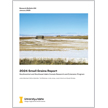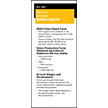Irrigation
Packed with tons of agronomic data, disease ratings and end-use quality data — interspersed with reports about planting and weather conditions, insect and diseases issues and more. This 146-page...
Packed with tons of agronomic data, disease ratings and end-use quality data — interspersed with reports about planting and weather conditions, insect and diseases issues and more. This 162-page...
Agronomics of Leasing Fields for Potato Production
Leasing or renting fields for potato production may make it easier for growers to either start an agricultural career or expand one but be forewarned: gather as much background information as you...
Buckwheat Production West of the Cascades
Naturally gluten-free, buckwheat has a variety of culinary uses regionally and internationally. Learn about market opportunities, how to establish a strong stand, and the best management and...
This bulletin describes the water requirements of the corn crop and explains how to manage a center pivot irrigation system to deliver enough water to the crop at the right times. It focuses on...
Cultural Management of Clearwater Russet Potatoes
The Clearwater Russet is a russet-skinned potato variety developed by the Pacific Northwest Variety Development Program that was released in 2008. Its excellent processing quality helped to...
In our Farmer-to-Farmer Cast Study Series, explore innovative approaches that regional farmers are using to increase their resilience in the face of a changing climate. In this case study, Jake...
Estimating Water Requirements of Hard Red Spring Wheat for Final Irrigations
This publication teaches how to use the soil "feel and appearance method" and information on crop stage and soil type to determine whether and how much to irrigate. Authors: Roger Ashley, Larry...
Estimation of Sugar Beet Yield and Quality with UAV-Based Sensors
Efficient nitrogen (N) and water management are key for maximizing sugar yield in sugar beets. UAV-based remote sensing is increasingly being using as a tool for in-season N and water management...
Evaluating LESA Irrigation Systems in Potato Production in Southern and Eastern Idaho
Low-elevation spray application (LESA) is an irrigation modification that places nozzles 1-2 feet aboveground. The lower nozzle height in LESA enables water droplets to spend less time in the air,...
Idaho Spring Barley Production Guide
Barley is one of Idaho’s most important crops. Although its harvested acreage has decreased in the past twenty years, the state is still the nation’s top barley producer. Published in 2003, this...
Inland Pacific Northwest Pasture Calendar
The Inland PNW Pasture Calendar is a comprehensive guide intended to help improve grassland management of forage-livestock systems in the region. From eight chapters and eighteen appendices, learn...
Irrigation and Nitrogen Fertilization Affect End-Use Quality of Spring Wheat of Three Market Classes
Water and nitrogen are key ingredients in successful cropping systems, particularly in the challenging climates of the semiarid and arid regions of the western United States. This publication...
Irrigation Scheduling Using Water-Use Tables
Poor irrigation management can reduce crop yields, degrade crop quality, foster disease and increase pumping costs. This publication has information on using water-use tables to irrigate crops...
Irrigation Systems for Idaho Agriculture
Discusses and compares agricultural irrigation systems: surface systems, sprinkler systems, micro-irrigation and drip irrigation systems. Author: Howard Neibling 8 pages
Managing Irrigation Water Quality for Crop Production in the Pacific Northwest
Learn how to use water analyses to choose appropriate water treatment and water management practices in irrigated agriculture. The publication covers kinds of tests, sample collection,...
Managing Salt-affected Soils for Crop Production
Salt accumulation in soil can reduce crop yields and destroy a soil’s structure if not managed effectively. In this 21-page publication, learn how to test for and evaluate the salts present in...
This two-page fact sheet for use in the field offers recommendations for growing onions in Idaho, with pointers or information on growth stages and development, planting, fertilization, irrigation,...
Planning Water Access for Small-Acreage Irrigators
Small acreage landscapes pose unique water-access problems, particularly when they are subdivisions of a larger-acreage property. Improve your navigation of these challenges by learning the basics...
Efficient irrigation management can increase marketable yield while reducing production costs by conserving water, energy and nitrogen fertilizer and while reducing potential groundwater...
Scheduling Irrigation with a Pressure Chamber (Part 1)
How to use a pressure chamber as a tool to help you schedule irrigation in wine grape vineyards. The two most important questions you need to answer for irrigation scheduling are "How much?" and...
Scheduling Irrigation with a Pressure Chamber (Part 2)
Step by step instruction on how to use a pressure chamber as a tool to help you schedule irrigation in wine grape vineyards. Alexander Levin walks through the steps of using a pressure chamber to...
Scheduling the Final Irrigation for Wheat and Barley
Water management during grain formation is more important than ever, particularly with urban expansion and the subsequent increase in municipal water use. By investigating crop water-use patterns...
Spring Barley Quick Facts (2023 Southern Idaho)
This two-page fact sheet offers recommendations for growing spring barley in southern Idaho, with pointers or information on growth stages and development, rotation and seeding, irrigation,...
Spring Hulless Food Barley Production Quick Facts
This two-page fact sheet offers recommendations for growing spring hulless food barley in southern Idaho, with pointers or information on nutrition, rotation and seeding, growth stages and...
Sugarbeet Irrigation Management Using Watermark Moisture Sensors
Overwatering of sugar beets is common and that's unfortunate, because it allows root disease to flourish. Reduce its possibility by learning about soil moisture sensors — how to install and use...
Targeted Tank Mixtures for Weed Control in Potatoes
Managing weeds in potato fields with an integrated approach — using all available cultural, mechanical, chemical and biological tools — is more effective than relying on any single weed-control...
Wheat Characteristics under Varied Irrigation and Nitrogen
Determining optimum water and nitrogen requirements is critical to improve the yield and quality of wheat grown in arid and semiarid regions of the western United States. Because wheat is an...


































